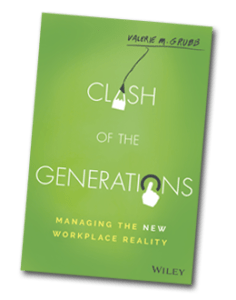Everyone’s talking about workplace diversity today, and for good reason: when you expand the range of perspectives, experiences, and characteristics of your team, you also extend your reach toward innovation and overall excellence. But gender and ethnicity dominate many of the discussions about diversity—and companies need to start talking more about an age diverse workplace as well.
Let’s play a quick round of the game “Three Truths and a Lie.” Which three of the following four statements are true—and which one is false?
- Older workers aren’t retiring at the same rate as their predecessors and are staying in the workplace longer than predicted.
- The workplace now includes members of at least four generations (and sometimes five or even six!).
- Older workers consistently report experiencing age-related discrimination in the workplace.
- Because older workers aren’t able to “change with the times” and are therefore incapable of learning new skills, they contribute much less than younger workers to today’s organizations.
If you pegged #4 as the lie, you’re right! Here are the details on each of those statements:
- A recent survey by the Gallup organization found that “whether by choice or necessity, baby boomers will remain a sizable proportion of the workforce in the years ahead, with many expecting to work past the average U.S. retirement age of 61 and even the traditional retirement age of 65.”
- The four generational groups that currently make up most of the workforce are the Baby Boomers, the members of Generation X, Millennials, and the members of Generation Y (sometimes called Postmillennials). Although they aren’t a statistically significant segment of the workforce, some members of the two generations that preceded the Baby Boomers are still working, too!
- In a survey conducted by AARP in 2013, “approximately two-thirds (64%) of older workers (ages 45–74) say they have seen or experienced age discrimination in the workplace.”
- When you look at the data, though, this stereotype falls apart. Researchers have found that, thanks to their life experiences, older people have significantly more innovation potential than youngers one.
How many times have you heard something along the lines of “older workers can’t contribute as much as younger workers”? We’ve all encountered the old saying “You can’t teach an old dog new tricks” before! (According to some sources, that one’s been around for at least 500 years!) Our culture promotes the idea that “younger is better”—a bias that’s promoted in the workplace by influential business leaders, too.
Rather than consider the multigenerational workplace as a liability or challenge, managers would be better off look at it as an opportunity. There’s a lot of talk about how Millennials are reshaping the workplace with new technologies, new attitudes, and new communication methods (e.g., social media). In their rush to embrace younger workers, though, companies are often ignoring (or, worse, abandoning) their older workers. And that is a huge mistake.
Why? In short, older workers bring their own experience, perspectives, skills, and insight to the workplace. That toolbox is unique to them and isn’t something that workers from other age groups share. (That said, those other workers bring their own unique toolboxes to the workplace.)
Companies that don’t embrace a multigenerational workplace are narrowing their options. And they’re hurting their bottom lines, too!
The most diverse companies also tend to be the most innovative. I’ve personally witnessed this to be true in many organizations. But don’t just take my word for it—take a look at the research that backs this up. And while you’re at it, take a look at study after study after study that has demonstrated the strong positive correlation between innovation and success.
What does all of this mean? It means that organizations that want to succeed need to work on building work environments that are diverse—and that this diversity needs to include age, too. It means that companies need to embrace an age diverse workplace. And if organizations want those older workers to stick around, they need to engage them, in part by recognizing the value of their contributions—and reducing or eliminating age-related bias among their managers and coworkers.

Whenever you put different groups of people together, some conflicts are bound to arise—and the workplace is by no means immune to this phenomenon. Knowing that a good chunk of management involves understanding employees’ motivations, backgrounds, and goals, I’ve learned how to negotiate and build on differences (and similarities!) among multiple generations in the office. Are you currently dealing with a “clash of the generations” at your own organization or want to be prepared for one that might arise in the future? If so, check out my new book, Clash of the Generations: Managing the New Workplace Reality (Wiley, 2016), which hits stores on October 31 and will be available in multiple formats (Amazon, Barnes & Noble, Powells) or contact me directly if you’re interested in signed copies.